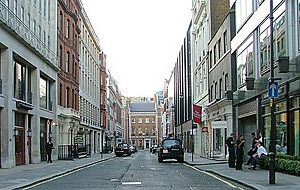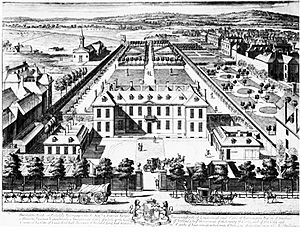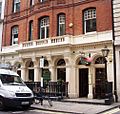Cork Street facts for kids

View north along Cork Street
|
|
| Namesake | Richard Boyle, 1st Earl of Burlington and 2nd Earl of Cork |
|---|---|
| Length | 420 ft (130 m) |
| Location | Mayfair, London |
| Postal code | W1 |
| Nearest Tube station | |
| south end | Burlington Gardens 51°30′35″N 0°08′28″W / 51.5098°N 0.1410°W |
| north end | Clifford Street 51°30′39″N 0°08′31″W / 51.5108°N 0.1420°W |
Cork Street is a famous street in Mayfair, a part of London, England. It is well-known for its many contemporary art galleries. In the past, it was also a hub for the tailoring industry.
Contents
Where is Cork Street Located?
Cork Street runs in a north-west direction. It starts near Burlington Arcade and Burlington Gardens. The street is also very close to Burlington House, which is home to the Royal Academy of Arts. Cork Street is parallel to, and just east of, New Bond Street. The closest tube station (subway station) is Green Park.
A Look at Cork Street's History
Cork Street is part of the Burlington Estate. This area was developed starting in the 1700s. The street gets its name from Richard Boyle, who was the first Earl of Burlington and also the second Earl of Cork, a city in Ireland.
Tailoring and Fashion History
For a long time, Cork Street and the surrounding area were famous for tailors. These were people who made custom-made clothes. Important tailors like Schweitzer and Davidson had shops on Cork Street during the Regency period. This was a time in the early 1800s when fashion was very important.
A famous fashion icon named Beau Brummell (1778–1840) was a customer of these tailors. He was known for introducing a very stylish way of dressing for gentlemen, called dandyism. Today, Savile Row, which is not far from Cork Street, is the most famous street for high-quality men's tailoring.
Cork Street's Art Scene
In the early 1900s, Cork Street started to become a center for art. It is now seen as one of the most important art areas in the United Kingdom. This is partly because it is so close to the Royal Academy. Many art galleries on Cork Street helped launch the careers of major modern artists in Britain.
For example, the Mayor Gallery held the first London exhibitions for artists like Francis Bacon, Max Ernst, Paul Klee, and Joan Miró. Also, Peggy Guggenheim, a famous art collector, opened her own gallery at number 30 in 1938. As of 2012, there were 22 art galleries on the street.
A well-known art dealer named Lillian Browse was even nicknamed "The Duchess of Cork Street." She used this name for her autobiography, which is a book about her own life.
The Grey Organisation's Art Protest
In 1985, a group of artists called the Grey Organisation did something unusual. They covered some of the art galleries on Cork Street with grey paint. In a statement, they said the galleries were "boring and lifeless." They wanted to "liven up their lives a bit!" This event happened early in the morning on May 21, 1985.
Members of the Grey Organisation were later questioned by the police. However, they were released without any charges. This event showed how some artists wanted to challenge the traditional art world.
Protecting Cork Street's Art Future
In 2012, a group called the "Save Cork Street" campaign was started. Their goal was to protect the area as a place for contemporary art. There were plans to redevelop the street, which could have meant fewer art galleries.
The campaign gained a lot of support, with 13,000 people signing up. Famous artists like David Hockney and Sir Peter Blake also supported it. The "Save Cork Street" committee asked the local council to make sure that future buildings on Cork Street would still be used for art galleries.
Images for kids
-
Mulligans of Mayfair, an Irish restaurant at 13 Cork Street (now closed).
Art Galleries on Cork Street Today
- Alison Jacques, 22 Cork Street
- Alon Zakaim Fine Art, 27 Cork Street
- Browse & Darby, 19 Cork Street
- Flowers Gallery, 21 Cork Street
- Goodman Gallery, 26 Cork Street
- Holtermann Fine Art, 30 Cork Street
- The Mayor Gallery, First Floor, 21 Cork Street
- Messums, 28 Cork Street
- Nahmad Projects, 2 Cork Street
- No.9 Cork Street, 9 Cork Street
- The Redfern Gallery, 26 Cork Street
- Stephen Friedman, 5–6 Cork Street
- Waddington Custot, 11–12 Cork Street
Past Art Galleries on Cork Street
- Lisson Gallery
- Saatchi Yates
- Mayor Gallery
See Also
- Burlington Arcade, a famous shopping arcade across from Cork Street
- Dover Street, another street nearby in Mayfair with many art galleries




